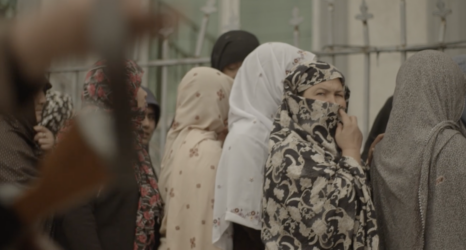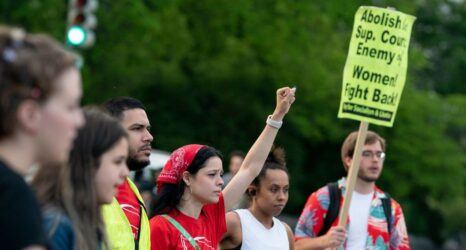Amani, a 10-year-old refugee from Syria, wants to be a pilot when she grows up. To an outsider, this may seem unlikely. She and her family have fled the deadliest conflict in the world. She lives in a region where girl’s roles are often placed upon them rather than created by them. The closest she’s come to a plane is when U.S. and Jordanian aircrafts pass to Syria each week. Still, she has reason to be hopeful, stopping to look up when planes fly overhead.
Amani is part of the Vision Not Victim project, a mentorship initiative in collaboration with the International Rescue Committee. “Women and girls in conflict zones are usually portrayed as powerless,” says Meredith Hutchison, age 30, the program’s founder and principle photographer. “We rarely see photos of a Syrian woman who has experienced trauma and faces challenges but also has agency. Women have ideas about how to create solutions and how to build peace. I wanted to find a way to capture powerful images and make the process itself empowering.”
Founded in 2013, Vision Not Victim takes photographs of refugee girls in their dream jobs, to help them regain control of their narratives. It has invested in 75 girls so far, from three regions: Jordan, The Ivory Coast and The Democratic Republic of Congo. The girls selected are already part of existing IRC programs for vulnerable youth. This means that before a camera comes out, participants and their families have attended trainings on safety, community leadership and girl’s education. IRC staff will be with them before and after the project is through. Once selected for Vision Not Victim, the girls are invited to weekly meetings to imagine their future.
“In most places where we work, girls are never asked what they want to be when they grow up,” Meredith says. “Approaching the question is a new concept for them. Professional women from the community—teachers, lawyers, businesswomen, artists, doctors and politicians—help by speaking about their careers. Many are former refugees themselves.”
From there, the girls are asked to create concept drawings, visualizing their dream job. They are asked: what would it look like? Who would be there? What would you be wearing? What would you be saying? Weeks later, the sketches are recreated in a photo shoot in an actual location. Girls who want to be doctors find themselves touring hospitals in a camp, shadowing medical professionals and looking at X-rays. Amani always wanted to be a pilot.
The project is knowingly ambitious. Being able to walk alone safely in a camp can be unrealistic for these girls, let alone running a business one day or flying a plane. They are part of the 65.3 million displaced persons in the world—a demographic where young women are prone to child marriage, sexual violence, lack of education and harassment. Still, Vision Not Victim is committed to taking the girl’s dreams at face value.
When a little girl in Zaatari refugee camp said she wanted to be a lawyer, IRC staff drove her out of the camp to see courtrooms and meet with female lawyers and judges in Amman. When a shy 11-year-old in the Ivory Coast said she wanted to be a mechanic, there were no female mechanics to call upon. But the IRC still found a garage willing to teach her. Soon, she was standing on a cinder block leaning over the hood of a car, looking into the engine. She was smiling and laughing, learning from hulking male mechanics four-times her size.
Meredith recalls a teenage girl who said she wanted to be a hairdresser early in the program. Vision Not Victim set up a shoot for her in a salon, but a few weeks later, the girl quietly re-approached them. “I said I wanted to be a hairdresser because my brother and father said it’s the only thing I could ever be,” she confided. “I know now that’s not true. What I really want to be is an architect.” They re-did the shoot with her as an architect.
The project requires fierce imagination: from the girls, their families, their communities and the world watching them. Everyone is asked to imagine and work toward a better trajectory. After receiving printed photos, one father sat in the corner of his house, silent and smiling, staring at the image of his daughter as a doctor. The daughter had been promised in an arranged child-marriage but after seeing the photo, he decided to call it off. Today, she is continuing with her education instead.
The IRC is already seeing results and is hoping to expand the program to more locations, including work with refugee girls resettled in the United States in the fall. With a goal of raising awareness and further funding, the pictures have been exhibited around the world: hanging in Istanbul, London, Washington D.C. and New York.
The pictures are also hanging in places like Zaatari refugee camp. Some of the girls have taped them up in small housing containers—their family’s only private space—beside a cut out window and mattresses on the floor. Jordan is home to millions of refugees, including Amani, that smiley 10-year-old future pilot.
Amani doesn’t know it yet, but female pilots in different countries have seen her picture and felt inspired. She’ll be receiving videos this week with women standing in their uniforms encouraging her. She’ll be opening packages with their wings and textbooks. She’ll read notes saying they believe in her, saying her dream is absolutely possible. “This is not about playing pretend,” says Meredith. “This is about letting them step into a moment in their future and giving them the tools to get there.”





